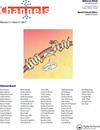糖,香料和钾通道调制
IF 3.2
3区 生物学
Q2 BIOCHEMISTRY & MOLECULAR BIOLOGY
引用次数: 0
摘要
如果考伯的论点是正确的,那么膜钾通道家族确实是辛辣而有味道的。线虫、果蝇和人类等范围广泛的生物体的基因组包含70个或更多的基因,这些基因编码形成不同种类钾通道的一个亚基。在DNA水平上增加这种多样性的事实是钾通道亚基mRNA在一些生物体中受到广泛的选择性剪接;由于钾通道是功能性四聚体,剪接变异体的蛋白产物可能以不同的方式结合产生大量具有不同功能特性的钾通道。仅举一个例子,果蝇的dSlo基因编码大电导(BK)钙和电压激活钾通道的一个亚基,可以被加工成144个剪接产物,这些剪接产物原则上可以结合起来产生多达144个(即近4.3亿个)不同的四聚体通道!简而言之,这些组合的可能性简直令人震惊。如果这还不够,大多数(如果不是全部)离子通道不单独由亚基组成的事实赋予了额外的结构和表型多样性。从离子通道纯化的早期就已经知道,形成孔的a亚基与所谓的辅助亚基(通常称为b, g等)有关,这些亚基对通道组装,膜靶向和功能起重要作用。最后,这些不同的亚基组合可以通过翻译后修饰来调节,包括磷酸化和糖基化,有时通过与离子通道蛋白本身密切相关的酶来调节。在《通道》杂志上发表的一篇论文中,Huang等人通过研究b2辅助亚基糖基化对小鼠BK通道mSlo的作用,增加了离子通道结构和功能多样性的故事。尽管如上所述,一段时间以来,人们已经知道b亚基糖基化可以影响通道的功能特性,但Huang等人更进一步,询问糖基化可能是这种调节的结构基础。为此,他们系统地突变了b2亚基胞外环中位于N链糖基化共识序列内的3个天冬酰胺(N)残基,并确定了N96的糖基化对于b2与mSlo a亚基的相互作用至关重要。这篇论文的一个有趣和不同寻常的特点是,作者并没有简单地止步于关键糖基化调节位点的鉴定,而是继续进行分子动力学建模,预测依赖于b亚基糖基化的a亚基的结构变化。这些建模研究的结论是,b2亚基糖基化促进了b2亚基与四聚体结构的结合,从而稳定了a/b2复合物的特定排列。这种“收紧”的结构可以解释功能的多样性本文章由计算机程序翻译,如有差异,请以英文原文为准。
Sugar and spice and potassium channel modulation
If Cowper’s contention is accurate, then the family of membrane potassium channels is spicy and flavorful indeed. The genomes of organisms as wide-ranging as nematode worms, fruit flies and humans contain 70 or more genes encoding the pore-forming a subunits of different kinds of potassium channels. Adding to this variety at the level of DNA is the fact that potassium channel a subunit mRNA is subject in some organisms to extensive alternative splicing; because potassium channels are functional tetramers, the protein products of the splice variants may combine in different ways to produce a large number of potassium channels with different functional properties. To give just one example, the dSlo gene in Drosophila, which encodes the a subunit of a large conductance (BK) calciumand voltage-activated potassium channel, can be processed into some 144 splice products, which could in principle combine to give rise to as many as 144 (that is, almost 430,000,000) different tetrameric channels from just a single gene! In brief, the combinatorial possibilities are nothing short of staggering. And if this were not sufficient, additional structural and phenotypic variety is conferred by the fact that most (if not all) ion channels do not consist of a subunits alone. It has been known since the early days of ion channel purification that the pore-forming a subunits are associated with so-called auxiliary subunits (often named b, g and so on) that contribute importantly to channel assembly, membrane targeting and function. Finally, these various subunit combinations can be modulated by post-translational modifications, including phosphorylation and glycosylation, sometimes by enzymes that are intimately associated with the ion channel protein itself. In a paper published in this volume of Channels, Huang et al add to the story of ion channel structural and functional diversity by investigating the role of glycosylation of the b2 auxiliary subunit on the mouse BK channel, mSlo. While, as indicated above, it has been known for some time that b subunit glycosylation can influence channel functional properties, Huang et al take things a step further by asking what the structural basis for this modulation by glycosylation might be. To this end they systematically mutate each of the 3 asparagine (N) residues in the extracellular loop of the b2 subunit that reside within consensus sequences for N-linked glycosylation, and identify the glycosylation of N96 as critical for the interaction of b2 with the mSlo a subunit. An interesting and unusual feature of this paper is that the authors don’t simply stop with the identification of the key modulatory glycosylation site, but they go on to carry out molecular dynamics modeling that predicts structural changes in the a subunit that are dependent on glycosylation of the b subunit. The conclusion from these modeling studies is that b2 subunit glycosylation promotes the association of the b2 subunits into a tetrameric structure that, in turn, stabilizes a particular alignment of the a/b2 complex. Such a “tightened” structure can account for the diverse functional
求助全文
通过发布文献求助,成功后即可免费获取论文全文。
去求助
来源期刊

Channels
生物-生化与分子生物学
CiteScore
5.90
自引率
0.00%
发文量
21
审稿时长
6-12 weeks
期刊介绍:
Channels is an open access journal for all aspects of ion channel research. The journal publishes high quality papers that shed new light on ion channel and ion transporter/exchanger function, structure, biophysics, pharmacology, and regulation in health and disease.
Channels welcomes interdisciplinary approaches that address ion channel physiology in areas such as neuroscience, cardiovascular sciences, cancer research, endocrinology, and gastroenterology. Our aim is to foster communication among the ion channel and transporter communities and facilitate the advancement of the field.
 求助内容:
求助内容: 应助结果提醒方式:
应助结果提醒方式:


